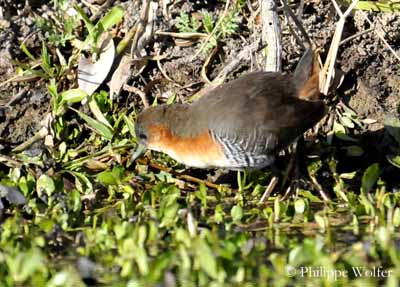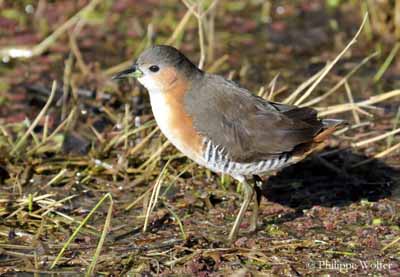
Fr: Râle brunoir
All : Rothalsralle
Esp: Polluela Burrito
Ital: Schiribilla pettobianco
Nd: Braziliaanse Dwergral
Sd: Rödsidig dvärgrall
Port: Sanã-parda
Photographers :
Philippe et Aline Wolfer
OISEAUX D’ARGENTINE
Text by Nicole Bouglouan
Sources :
HANDBOOK OF THE BIRDS OF THE WORLD Volume 3 by Josep del Hoyo-Andrew Elliott-Jordi Sargatal - Lynx Edicions - ISBN : 8487334202
RAILS - Barry Taylor and Ber Van Perlo - Pica Press - IBSN 1873403593
Avibase (Lepage Denis)
BirdLife International (BirdLife International)
SORA Searchable Ornithological Research Archive (Blair O. Wolf)
Rufous-sided Crake
Laterallus melanophaius
Gruiforme Order – Rallidae Family
BIOMETRICS:
Length: 14-18 cm
Weight: M: 60 g – F: 53-54 g
DESCRIPTION:
Four species of genus Laterallus occur in Paraguay, but the Rufous-sided Crake is the most widely distributed as well within this country as in South America.

Adult has grey-brown upperparts, including upperwing and uppertail.
On the underparts, chin, throat, breast and belly are white. The sides of head, neck and breast are orange. The body sides are finely but conspicuously barred black and white. The undertail-coverts are rufous.
Some birds can occasionally show narrow white barring on upperwing-coverts and scapulars, and others have buffy-orange colour from foreneck to breast.
These features are variable according to each bird.
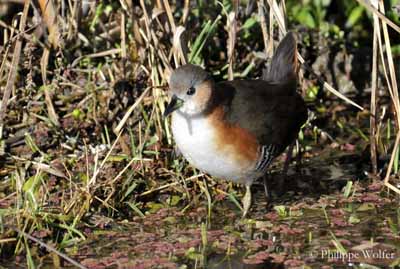
On the head, forehead, crown and nape are similar to the upperparts. Face is white and head sides are rufous-orange.
The bill is relatively long and fairly strong. It is black with greenish-yellow base sides. Eyes are dark brown. Legs and feet are greenish-brown.
Both sexes are similar with male slightly larger than female.
Immature resembles adults. Juvenile is duller and brownish-grey.
The subspecies L.m. oenops has paler olivaceous upperparts.
VOICE: SOUNDS BY XENO-CANTO
The Rufous-sided Crake frequently calls. It gives abrupt, explosive, descending trill “twewrrr…” and sharp “chip”, and also high peep “tsewip-tsip”. The alarm call is “psieh” and it utters short, soft, repeated “tsewrrr” in flight, even at night.
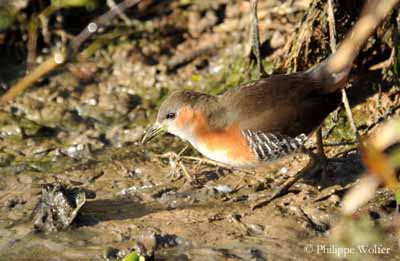
HABITAT:
The Rufous-sided Crake frequents the wetlands such as marshes and forages in the dense vegetation along the edges. It can be seen in wet meadows and usually close to water.
According to the range, it also frequents forests, mudflats, lagoons and dry grasslands in Venezuela. It is visible from lowlands up to 1000 metres of elevation.
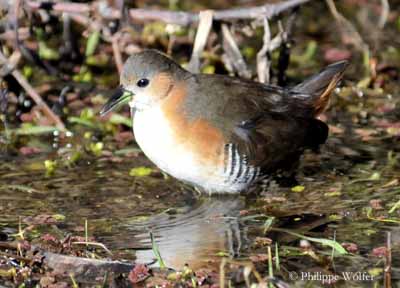
RANGE:
The race L.m. melanophaius occurs in coastal Venezuela, E to Surinam and S to C and E Brazil, to E Bolivia, Paraguay, Uruguay and North Argentina.
The race L.m. oenops occurs in SE Colombia, E Ecuador, E Peru and W Brazil.
BEHAVIOUR:
The Rufous-sided Crake forages on the ground and in shallow water. It feeds on insects, spiders and bugs, and takes occasionally seeds.
The strong legs and the long toes allow this bird to walk easily along the edges of marshes where it finds numerous invertebrates.

During the displays, the Rufous-sided Crake bobs the tail and exposes the rufous undertail-coverts. This behaviour is common in rails. They often walk while bobbing the head and flicking the tail.
When the bird is alarmed, the tail is spread and jerked before the rail reaches the cover.
During the breeding season, it probably performs typical displays such as exposing of the bold flank pattern and the rufous undertail-coverts. It calls frequently and especially while displaying.
This species is usually seen alone or in pairs.
The Rufous-sided Crake is probably sedentary with some local or seasonal movements.
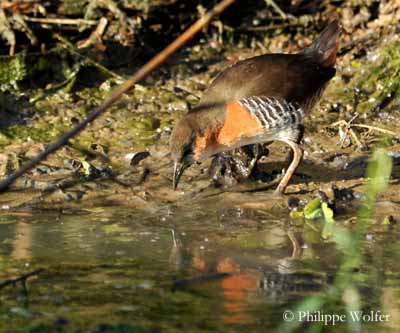
FLIGHT:
As in other Rallidae species, the Rufous-sided Crake has short, broad, rounded wings. It usually flies over short distances with dangling legs. The flight is low and weak, not sustained. This species prefers to run among the vegetation in order to escape a danger, rather than to fly.
REPRODUCTION:
The Rufous-sided Crake nests in the thick vegetation along the edges of the marshes, between 60 cm and one metre above the ground. The nest can be fairly deep.
In Laterallus species, the nest is usually domed with side entrance. It is made with woven leaves, stems or dry grass, and lined with feathers.
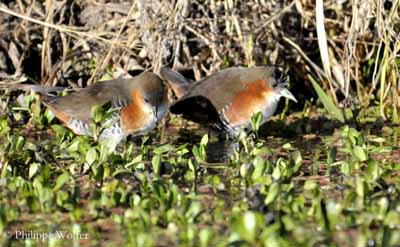
The female lays 4-5 eggs, in average 2 or 3. They are white with brown and reddish markings. They are laid at two days intervals and incubation lasts about 19-20 days.
At hatching, the downy chicks are black and they need four months to have the adult plumage. They leave the nest four days after hatching and fledge at three weeks of age.
This species may produce 2-3 broods per season. The young of the first clutch feed the young of the following brood.
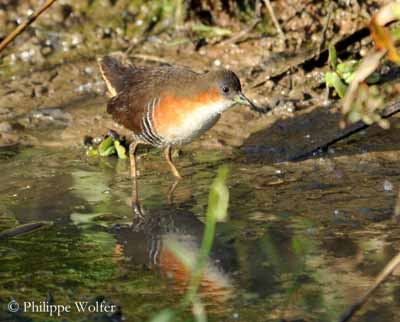
DIET:
The Rufous-sided Crake feeds on insects such as coleopterans, orthopterans, dipterans and also spiders, some seeds and leaves.
This species forages in shallow water, on the ground or on floating vegetation.
PROTECTION / THREATS / STATUS:
The Rufous-sided Crake is fairly shy and secretive, and difficult to see. This species is uncommon but the numbers appear stable. The populations are not currently threatened.
